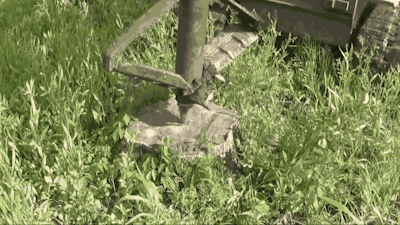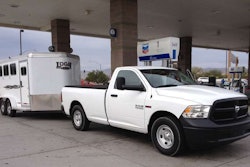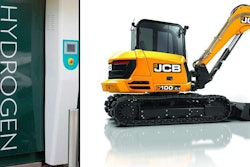 A sped-up look at the Stumpex in action. You can watch a real-time video below.
A sped-up look at the Stumpex in action. You can watch a real-time video below.When a land clearing contractor brought what eventually became the Stumpex attachment to Fecon, the concept still needed a lot of work to make it commercially viable. “We started working together and added some features that turned out to be very effective,” says Denis Goldbach, vice president, Fecon.
Fecon says the slow rotation, high torque attachment can grind 10- to 32-inch diameter stumps down 20 inches in 90 seconds, without flinging cuttings in a wide arc. Using a screw tip work tool and down pressure, the StumpEx first secures itself into the stump, and then quickly cuts it from the center using two flail cutting edges.
In comparison with a typical stump grinder that turns around 700 to 800 rpms, the StumpEx has a large reduction gear box and only turns around 17 rpm. And instead of shooting wood chips up to 30 feet, the attachment keeps most material within a small circle around the former stump. “It’s much easier to clean up after and it’s safer,” Goldbach says. “For example, if you’ve got to remove stumps between a street and a sidewalk, you don’t have to put up barriers and stop traffic.”
The 1,500-pound Stumpex can go up to 28 inches wide with one plunge. With a large stump—say one that’s 5 or 6 feet in diameter—Fecon advises taking several plunges around the stump. “We did a 5-foot diameter oak stump up in Canada that required about 6 or 7 penetrations down to 18 inches into the ground,” Goldbach says. “In 25 minutes, the stump was gone.”
Since it requires so little hydraulic pressure, the Stumpex can run on standard skid steer or excavator hydraulics, although the company recommends using high flow hydraulics.
The upper structure of the attachment contains the gear box and motor, while the lower structure is the working end. The lower structure can be unbolted to allow change-out to other attachments, such as post hole auger. The working edges are designed to last the normal life of the tool, requiring sharpening every 1,000 stumps. When the entire lower working end does need to be replaced, Fecon says it will have a core exchange program available.
Stumpex addresses one problem that causes grief with stump grinders: rock. “Grinders are turning so fast, rock can break expensive carbide tools,” Goldbach says. “With this, if you encounter rock, chances are it will just slowly push it out of the way. Or if it’s just too big, it will slowly push you to the side, and you can reposition and take another shot at it.”
The attachment will go intro production in May. Two different types of entry tools are available, one with closer-together flights designed to penetrate a stump faster at higher horsepower.













